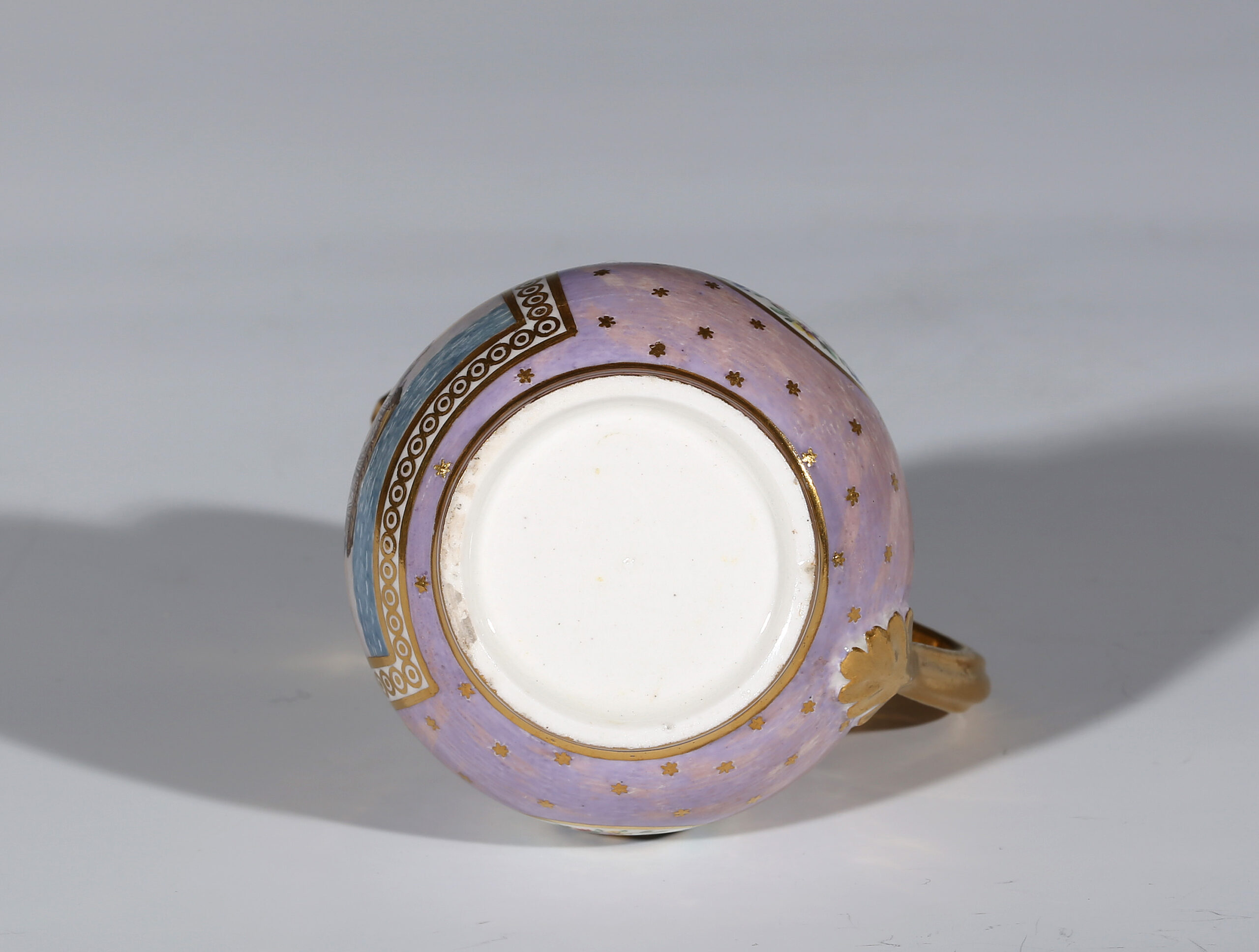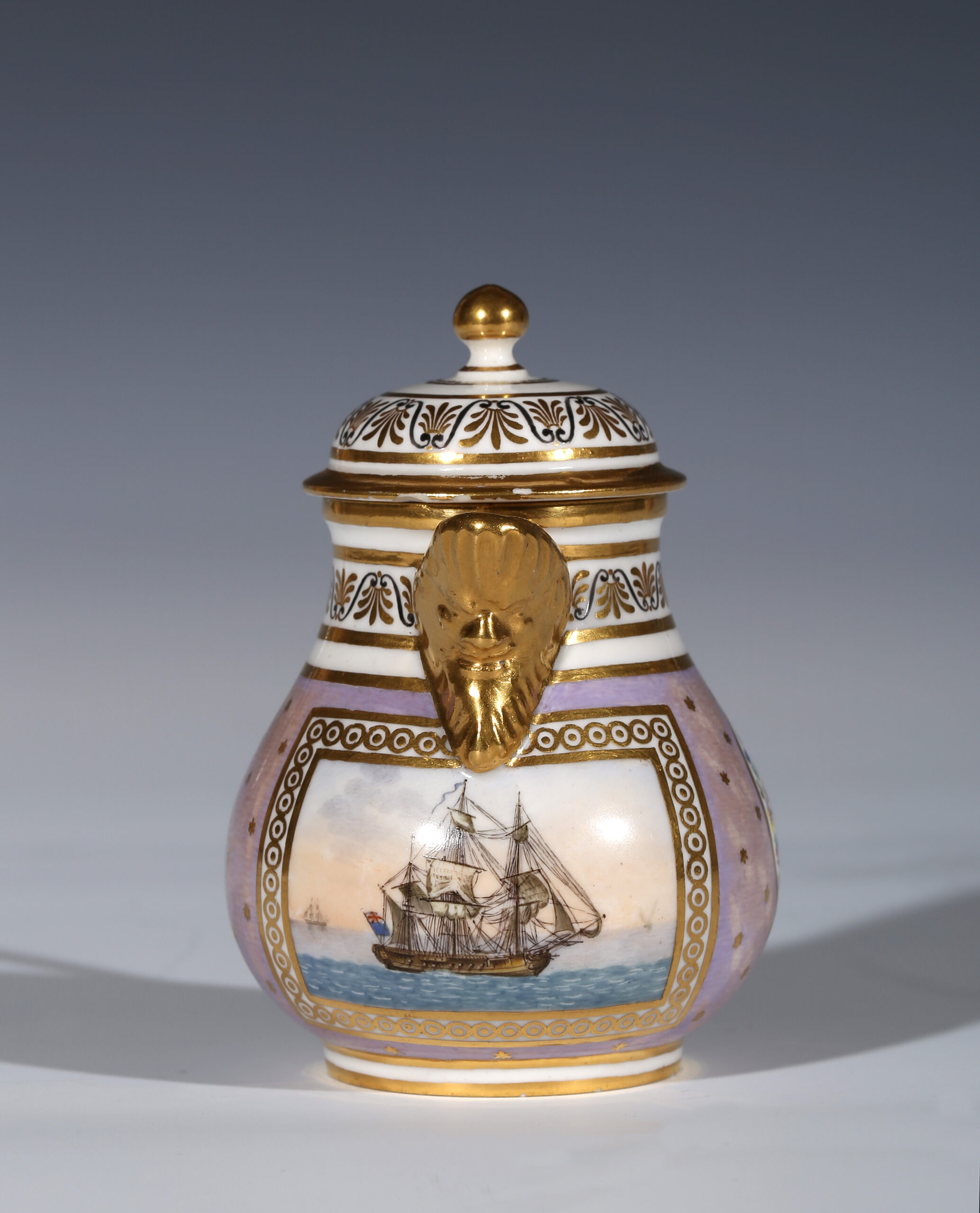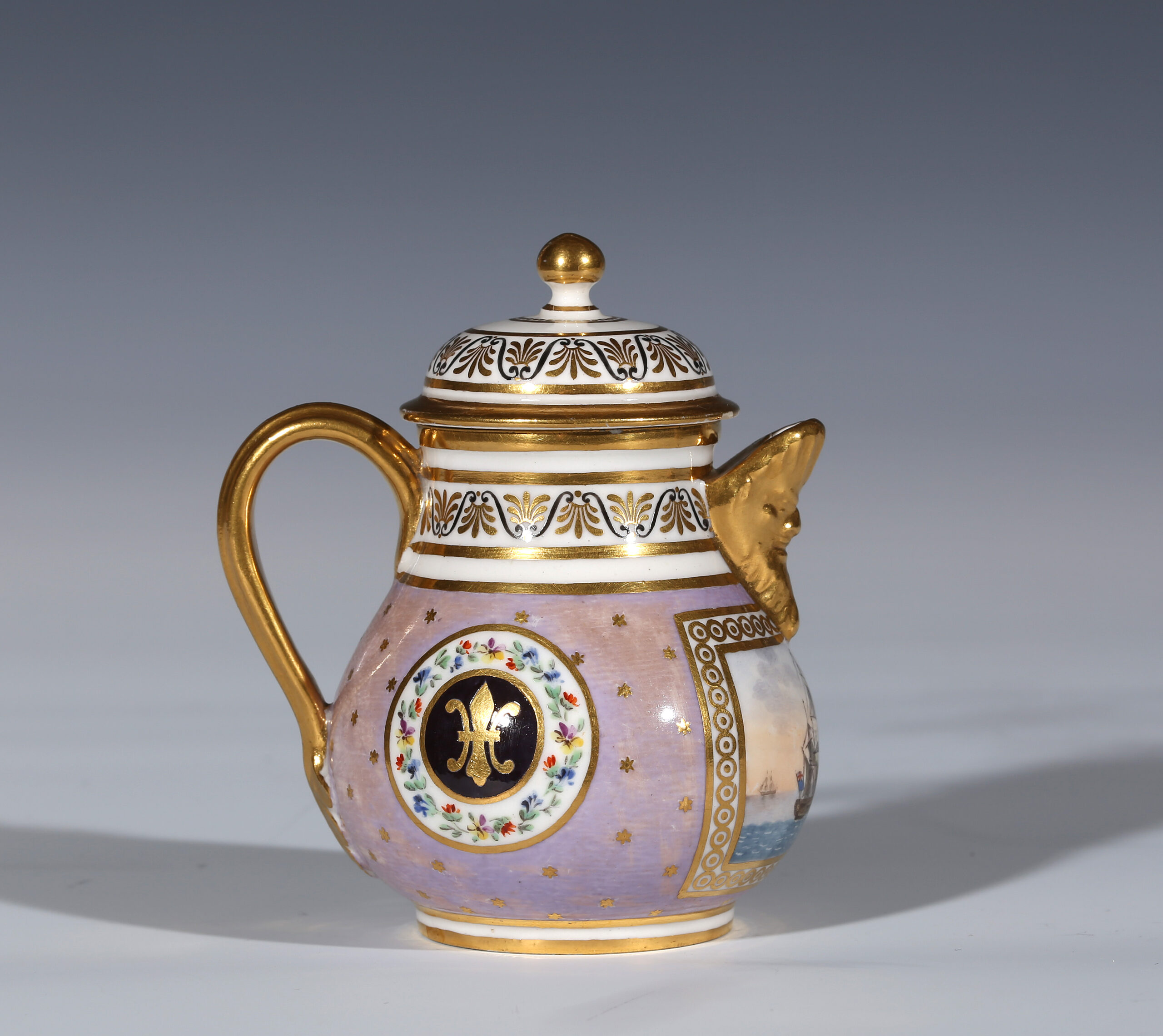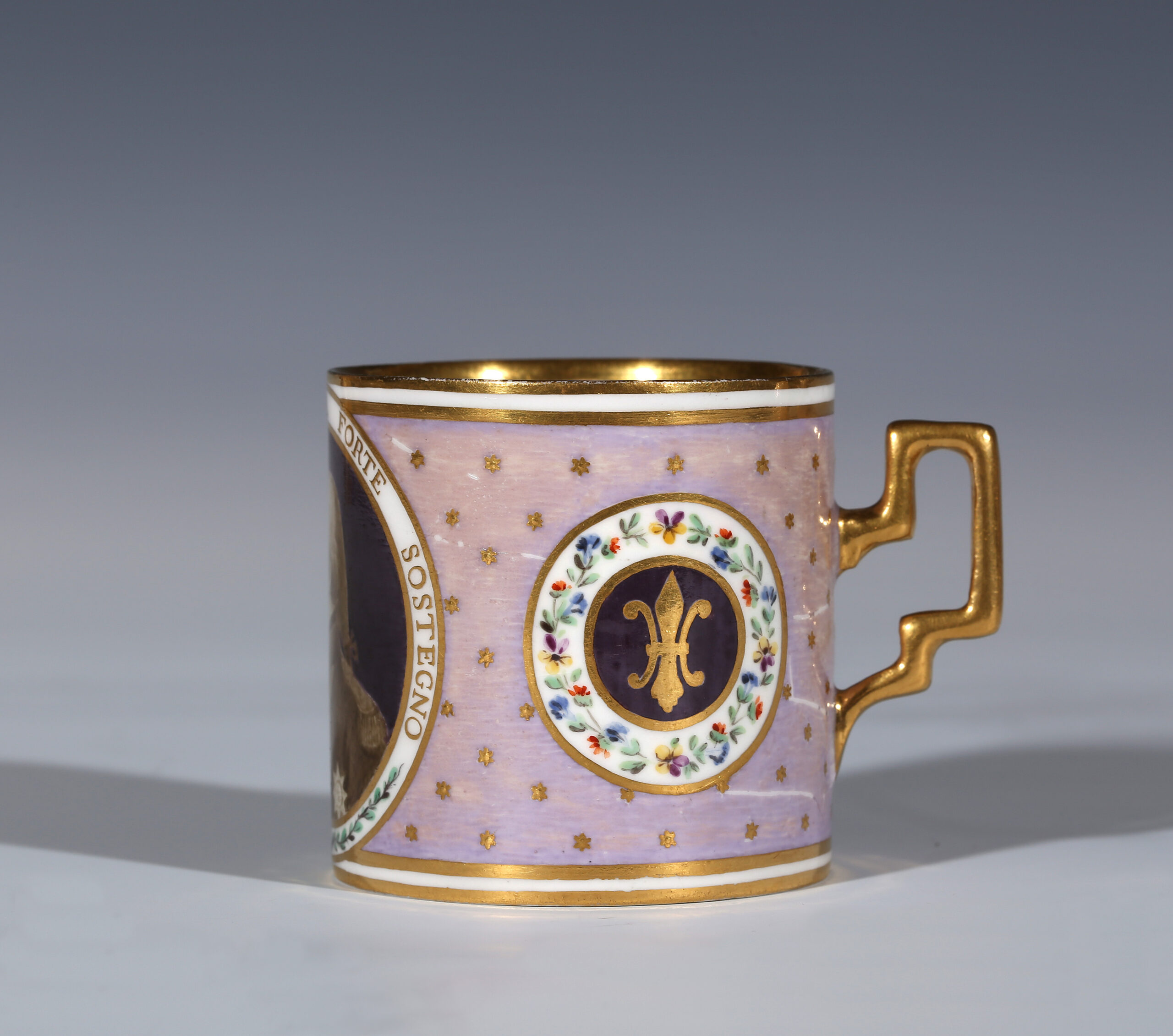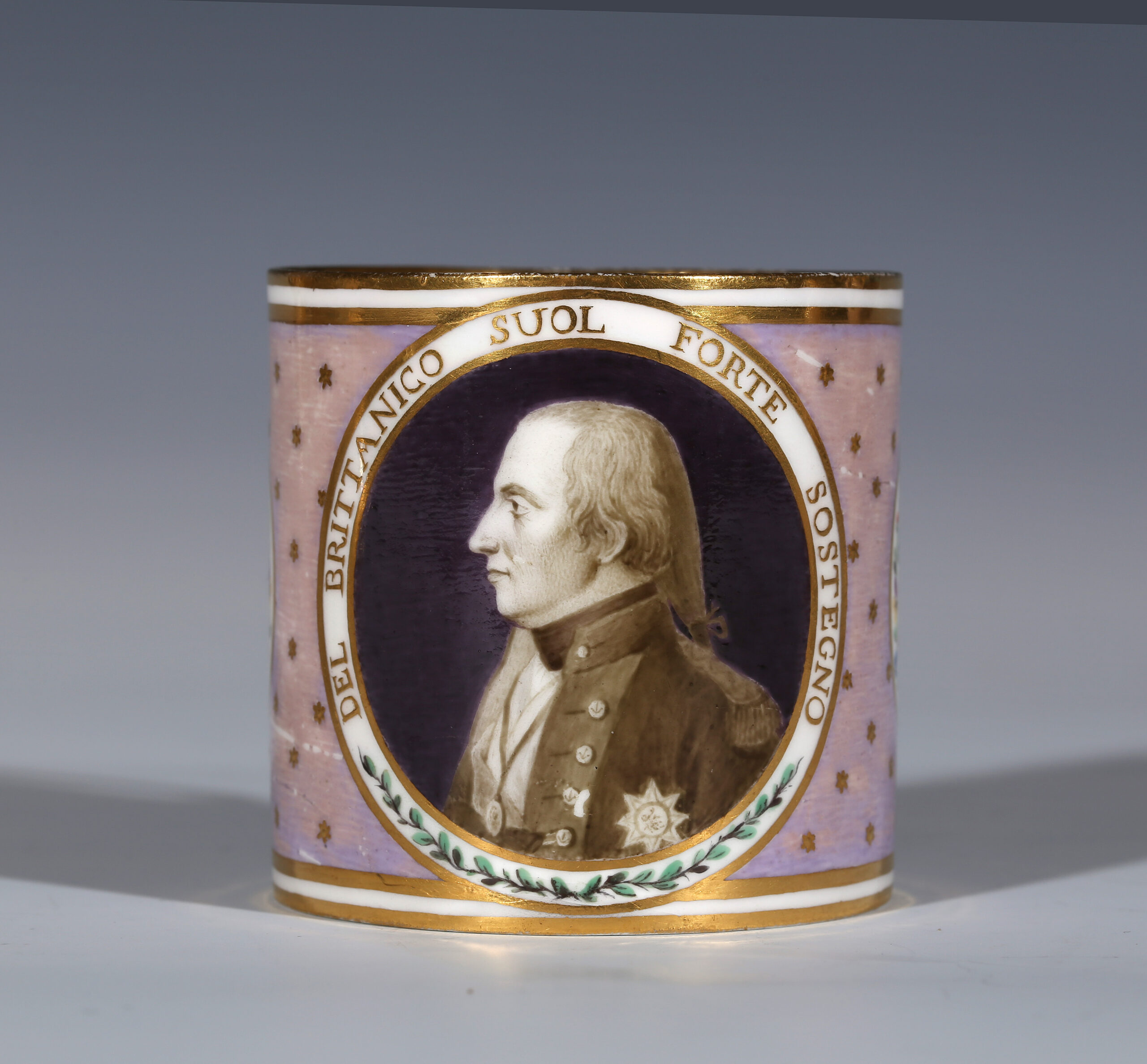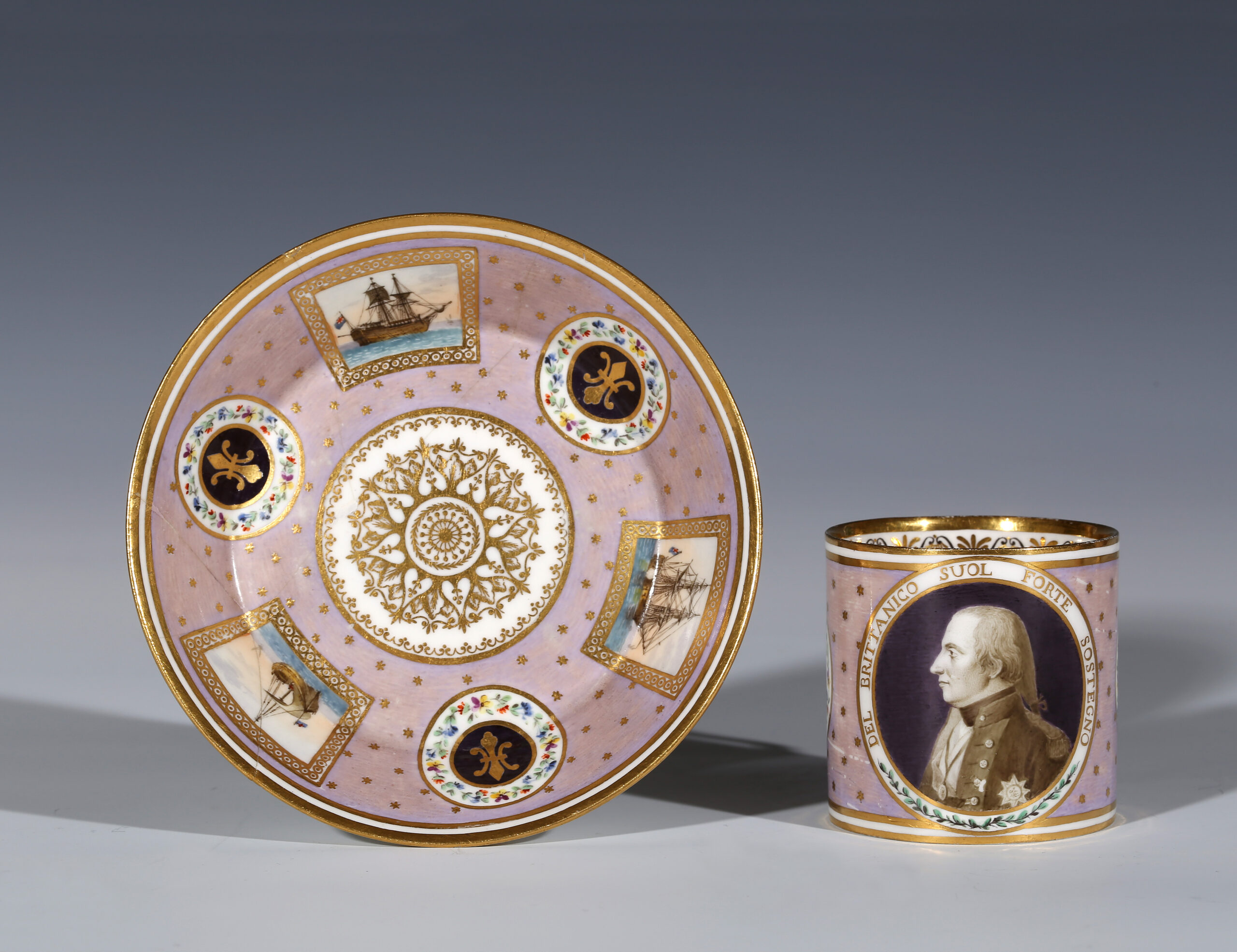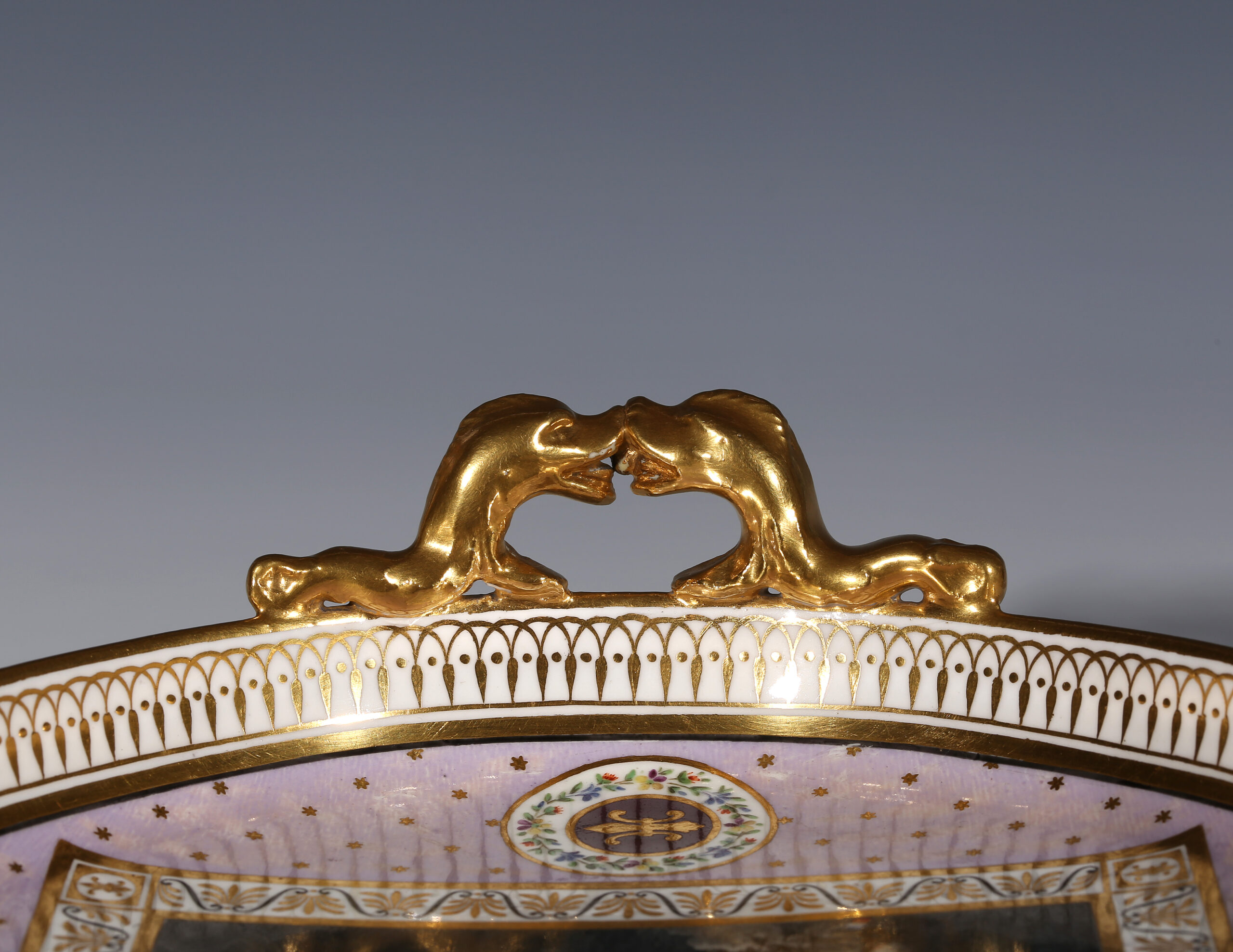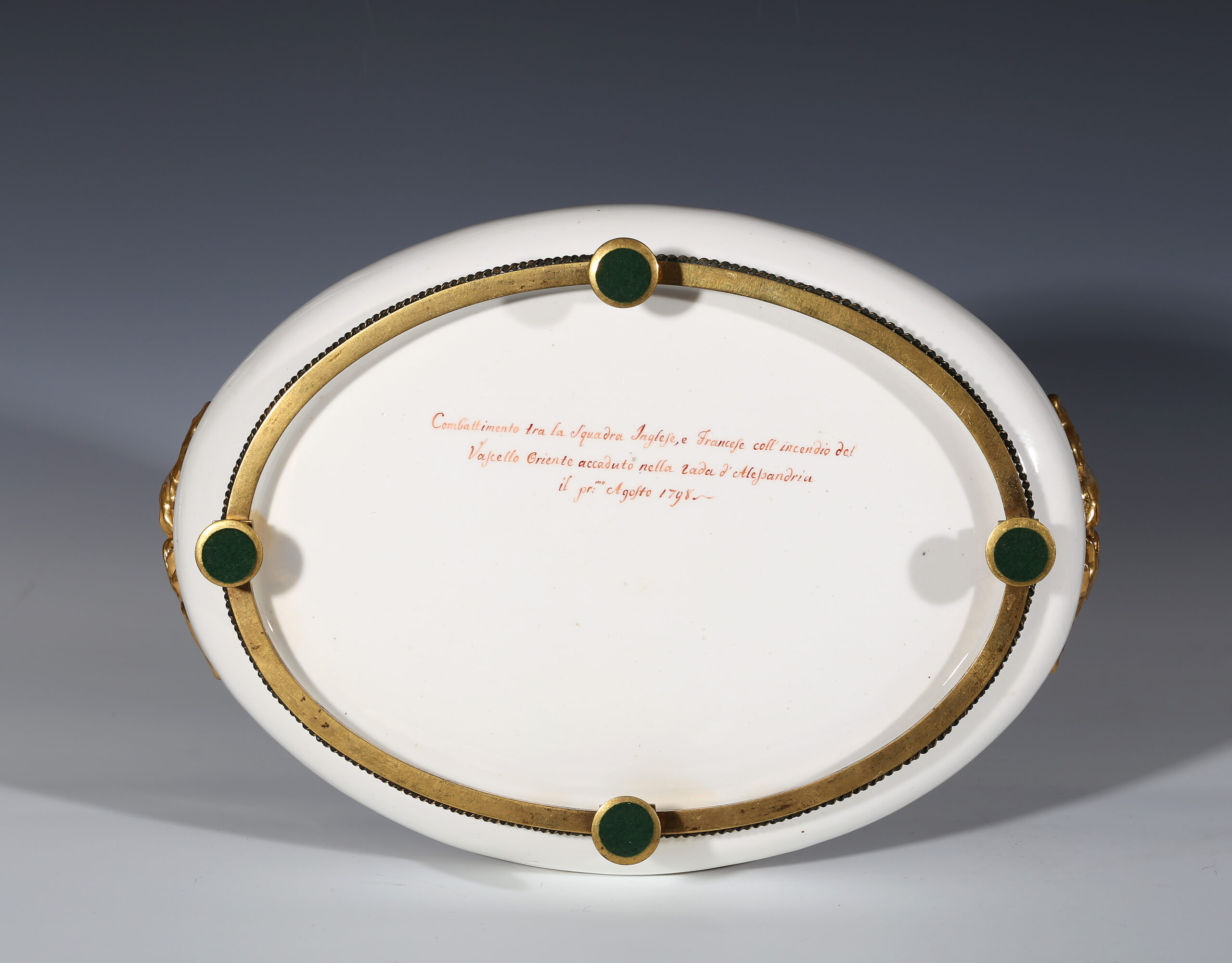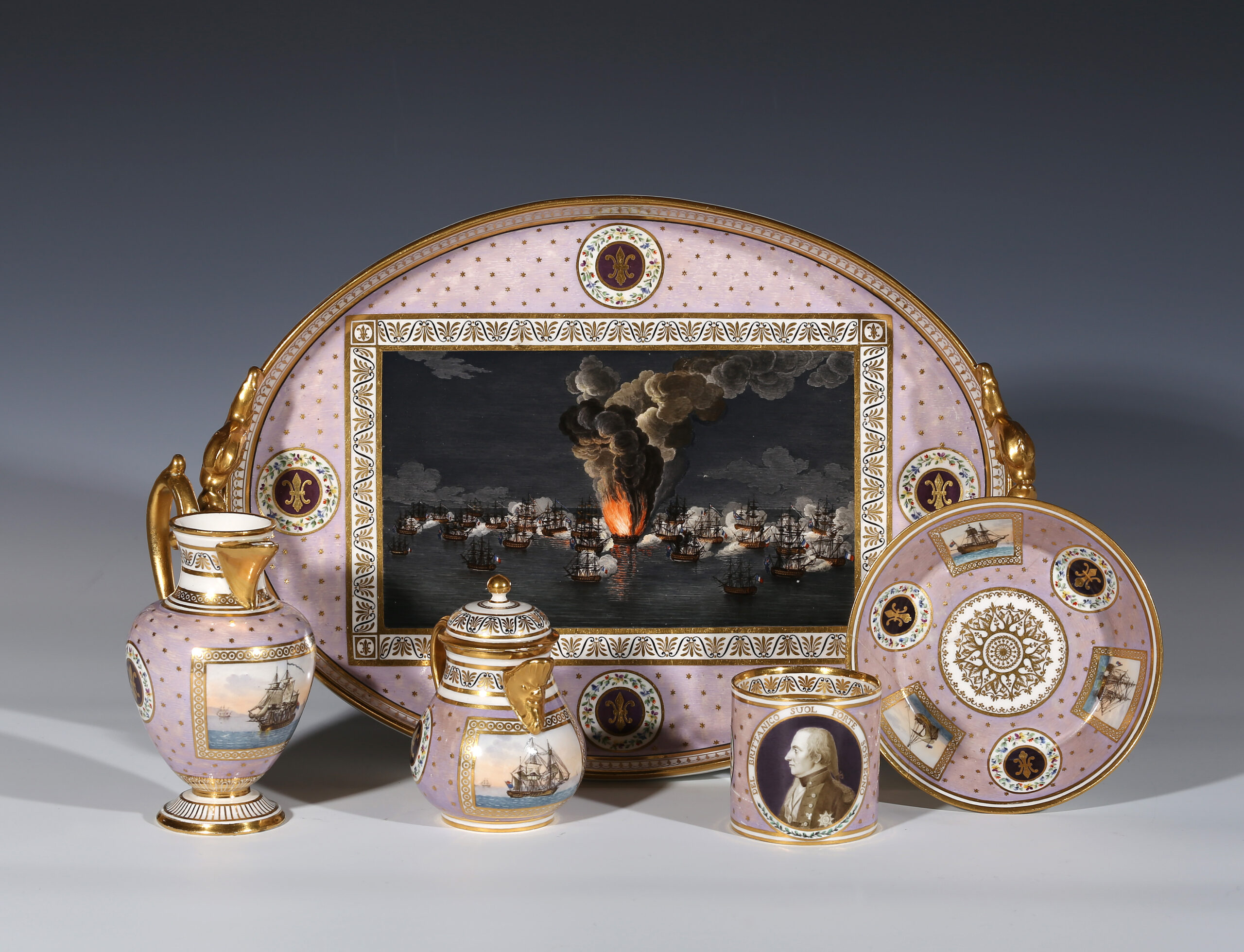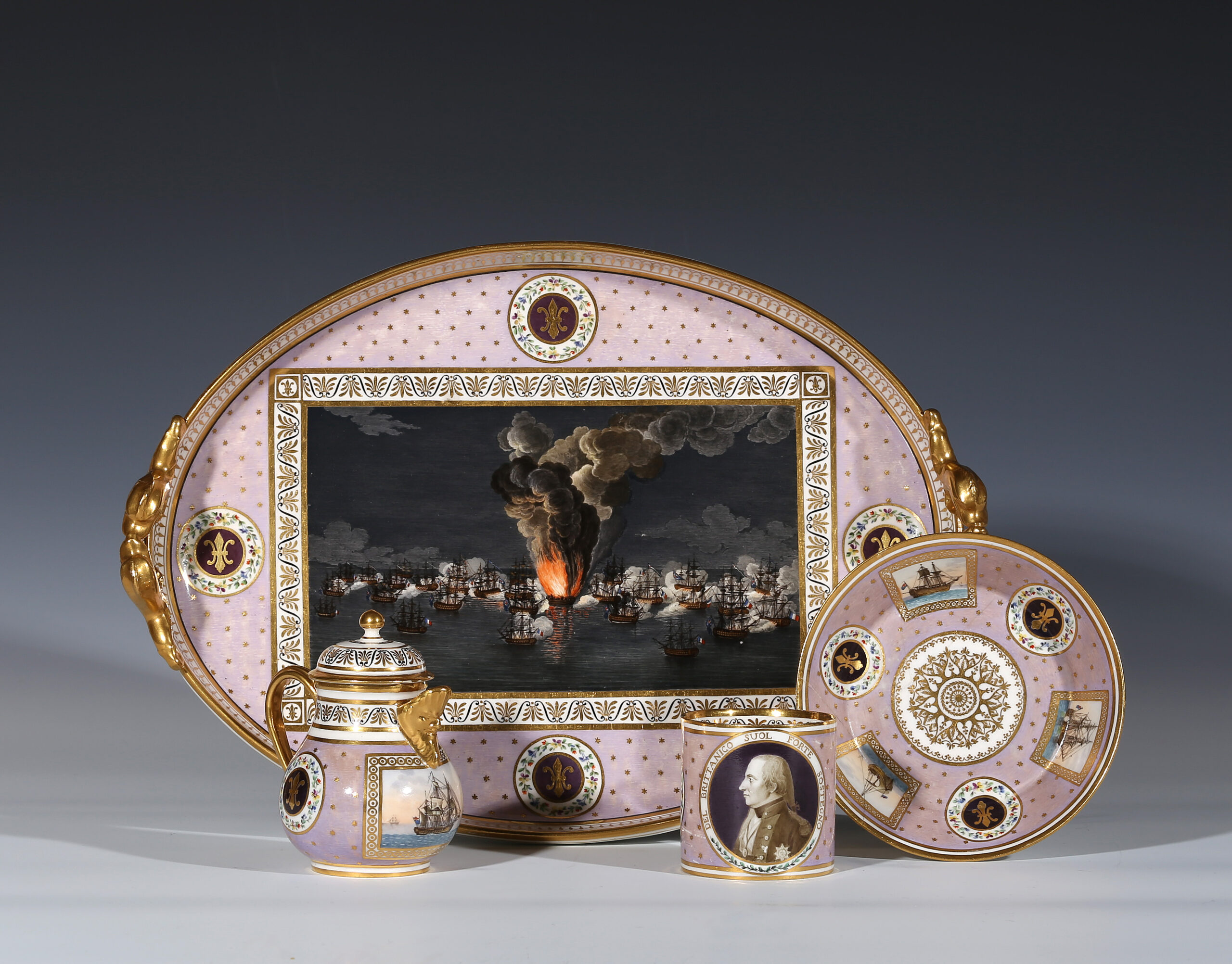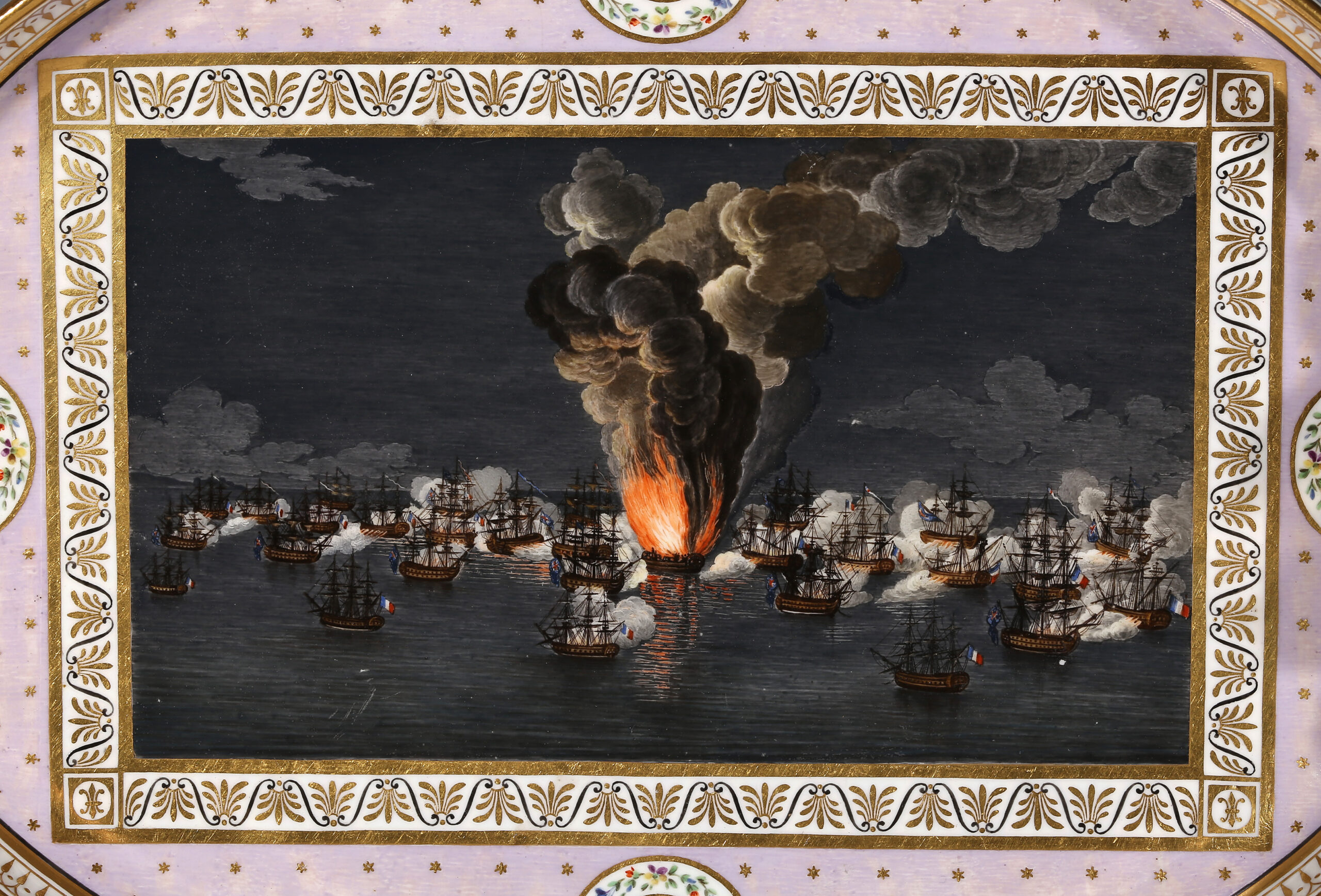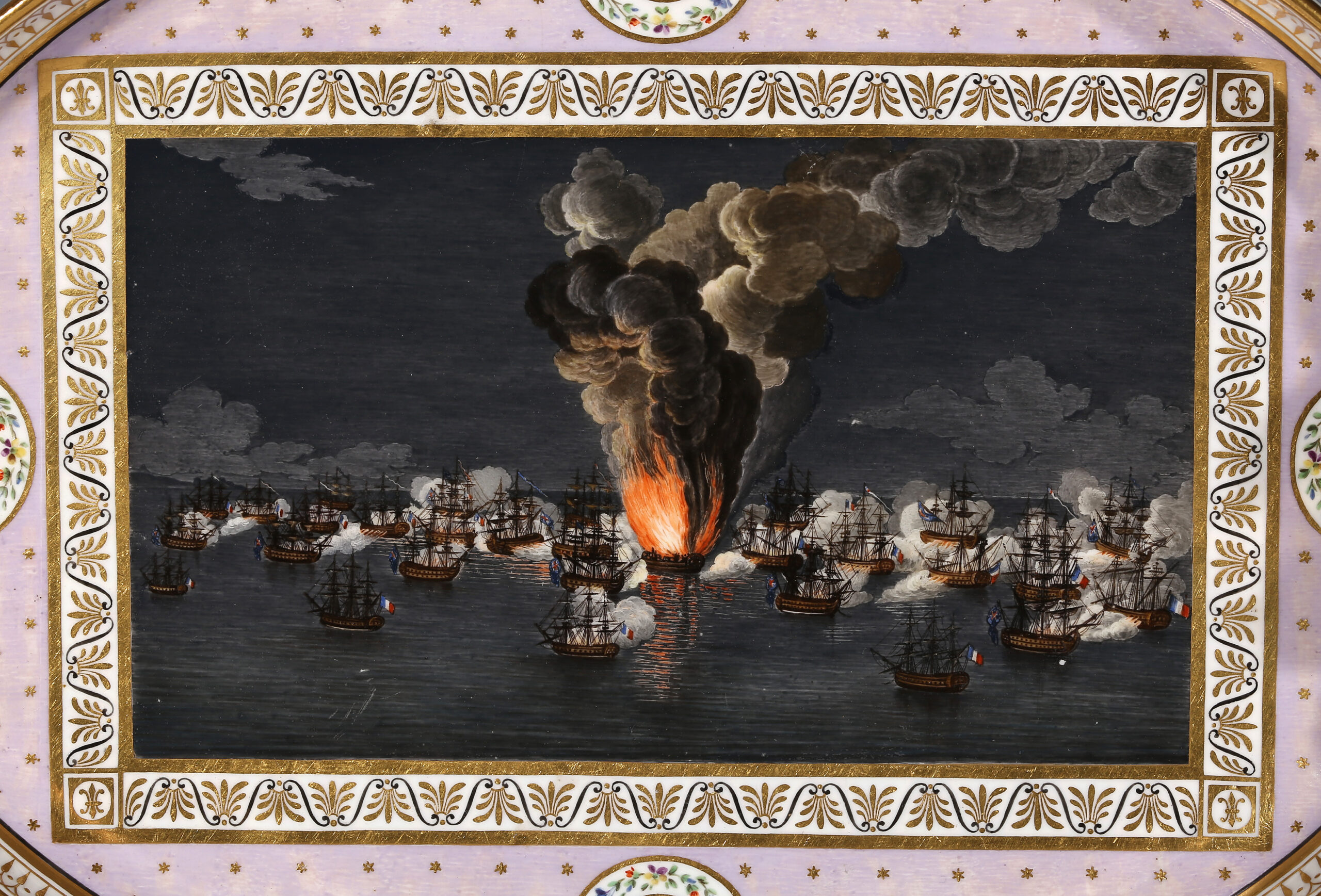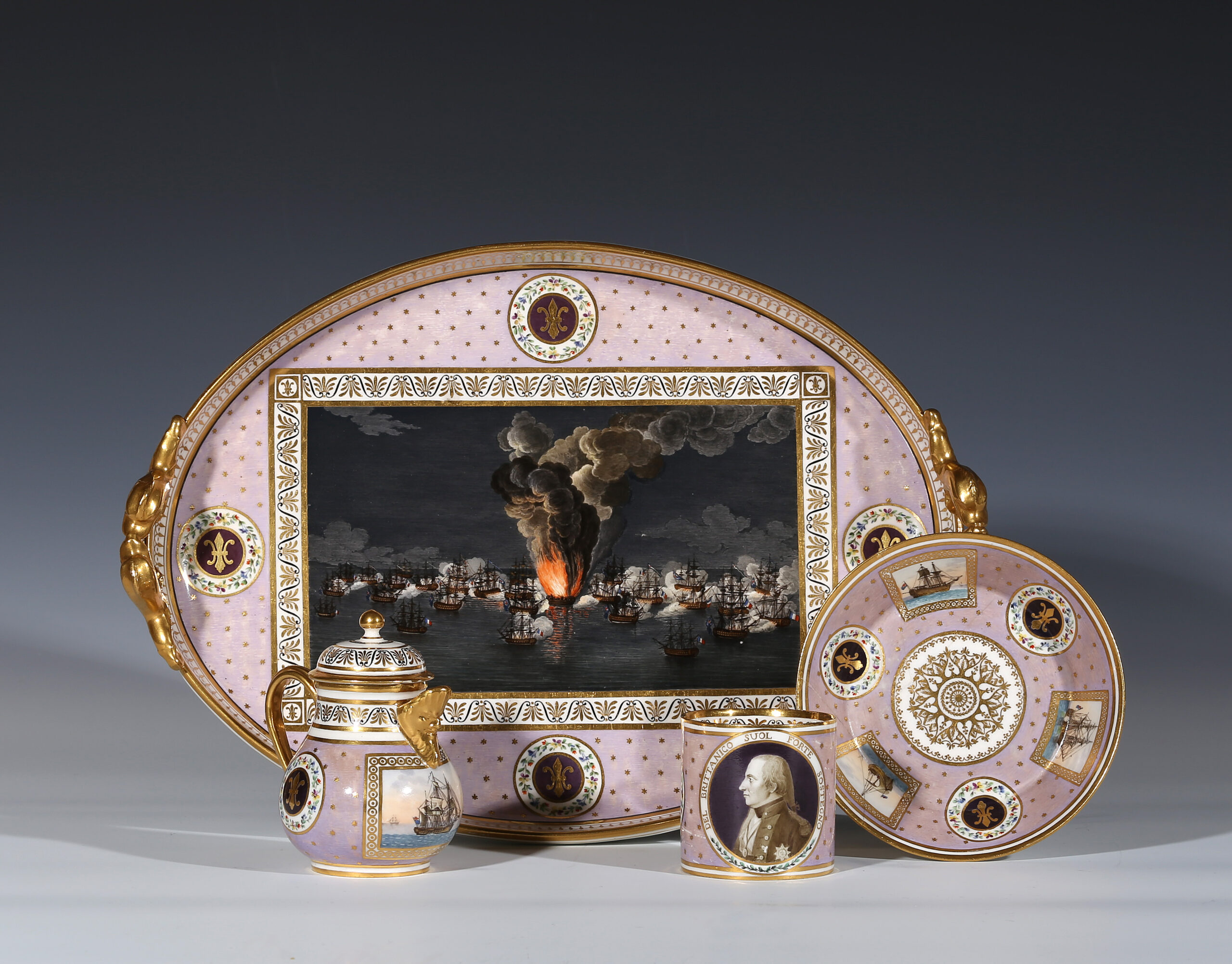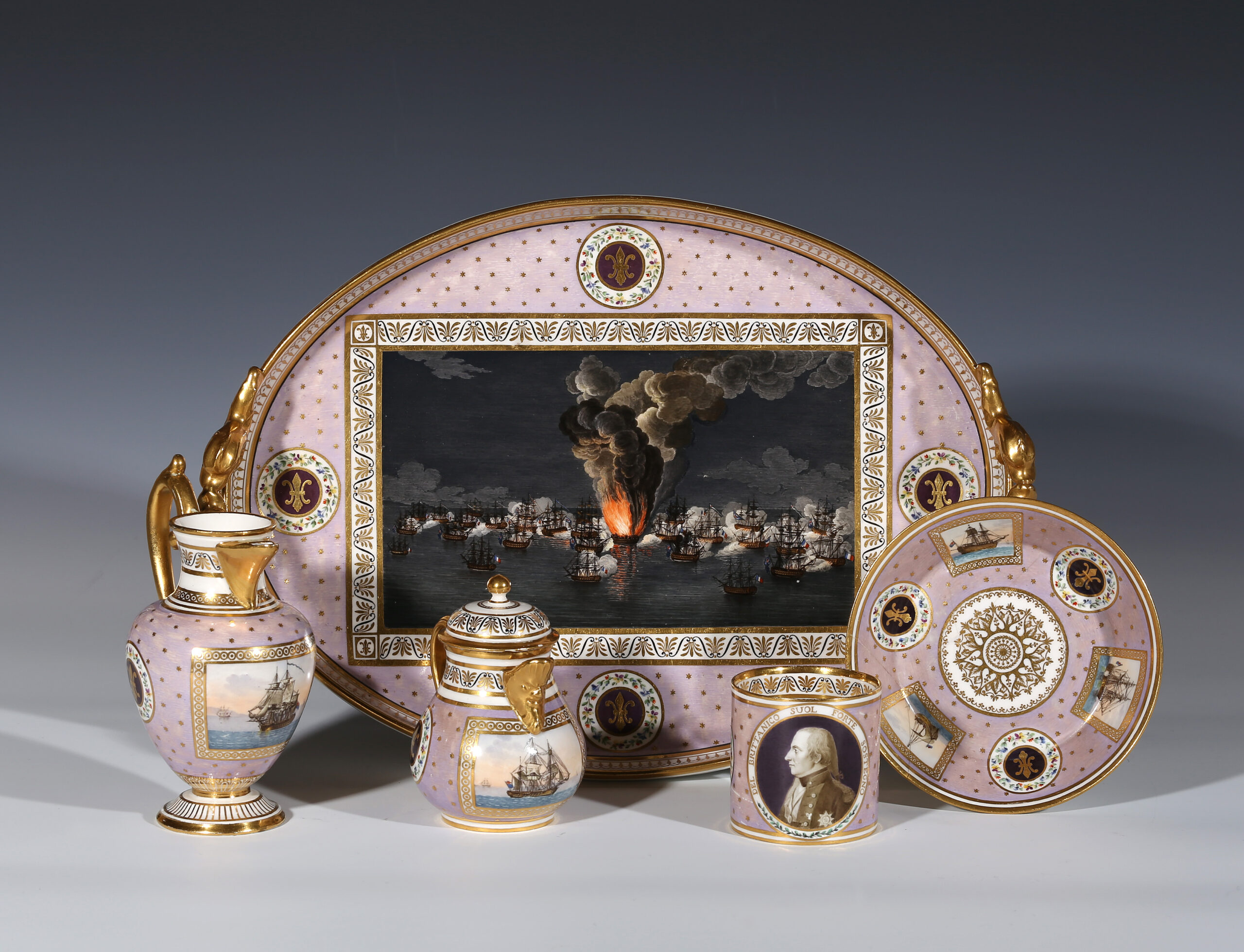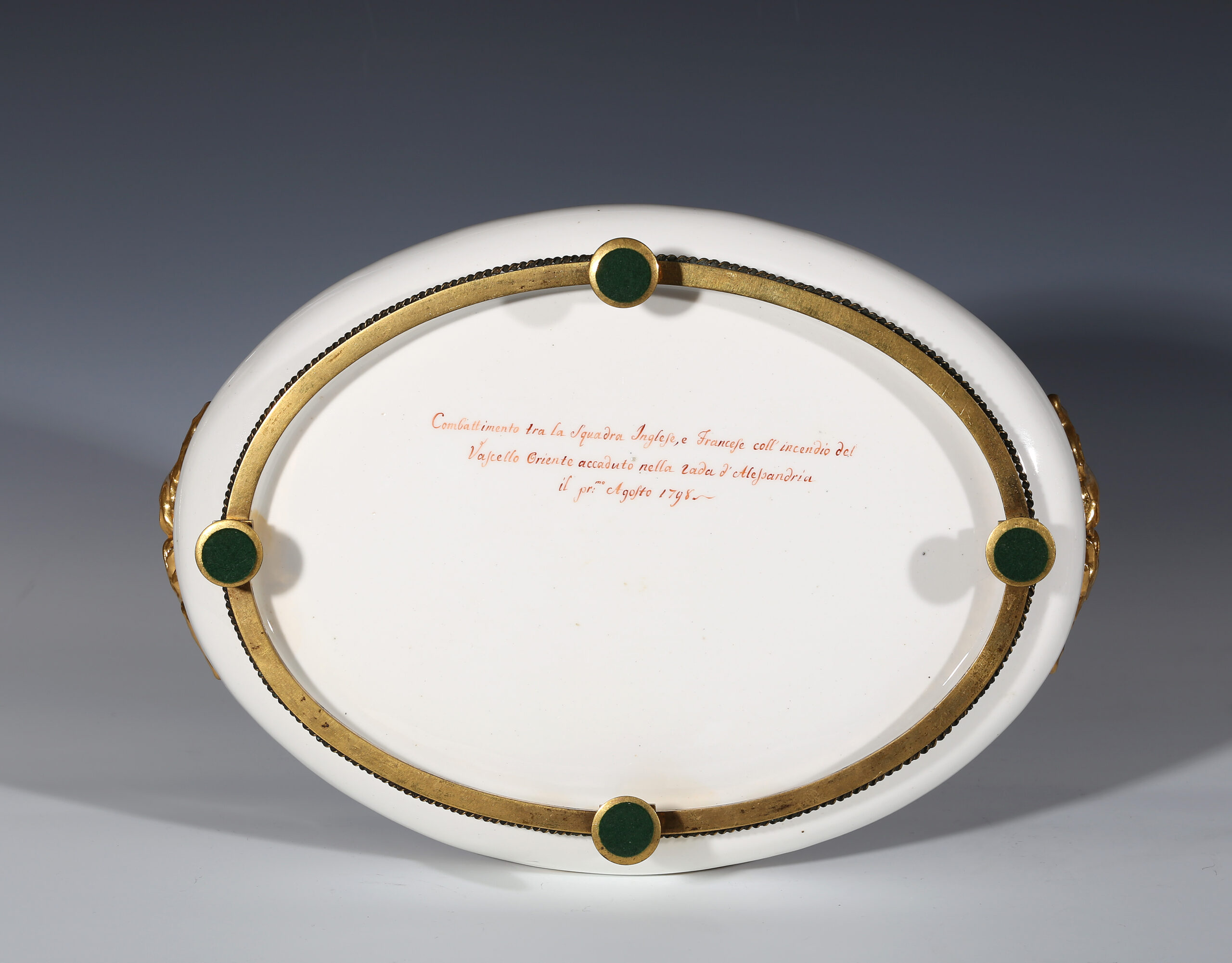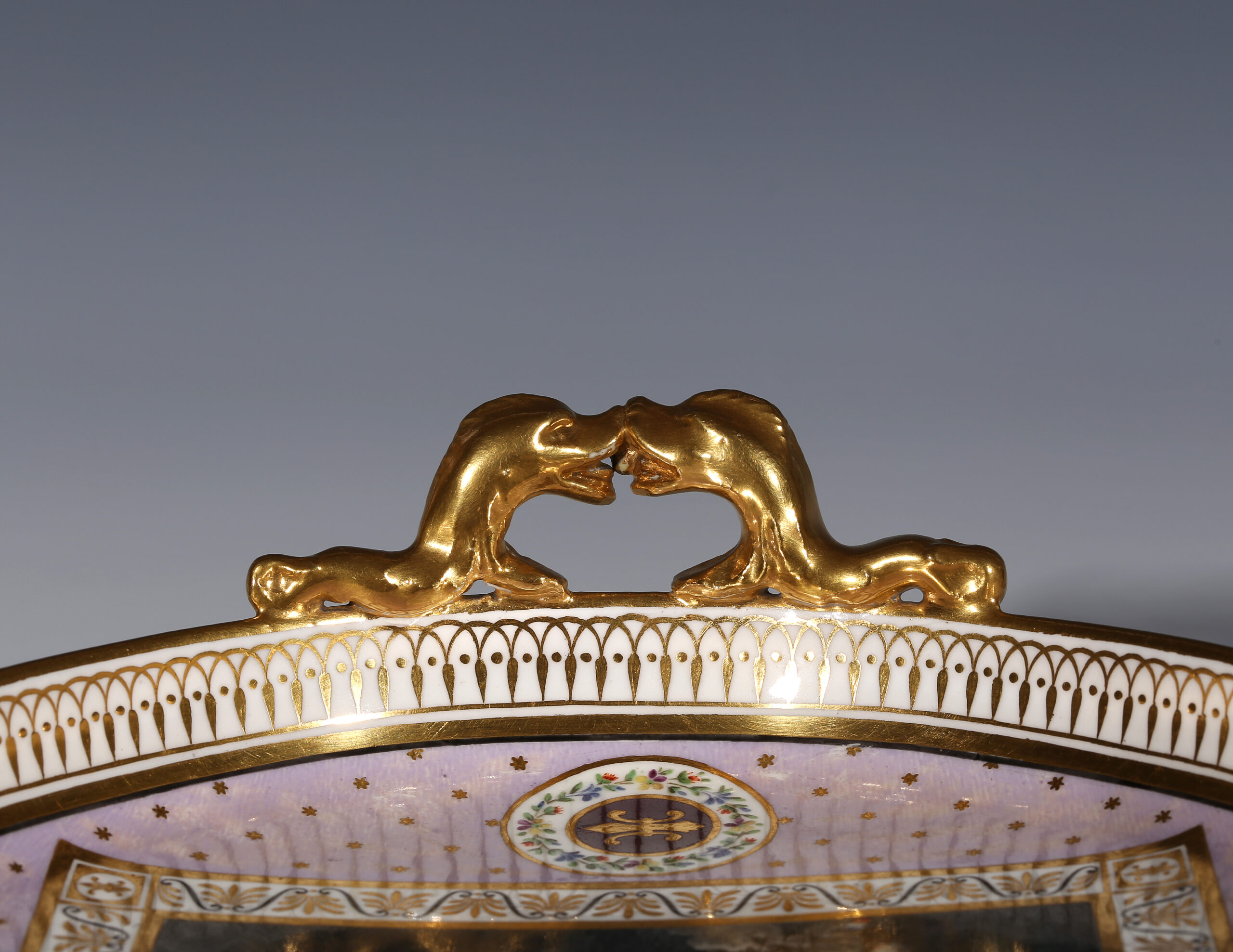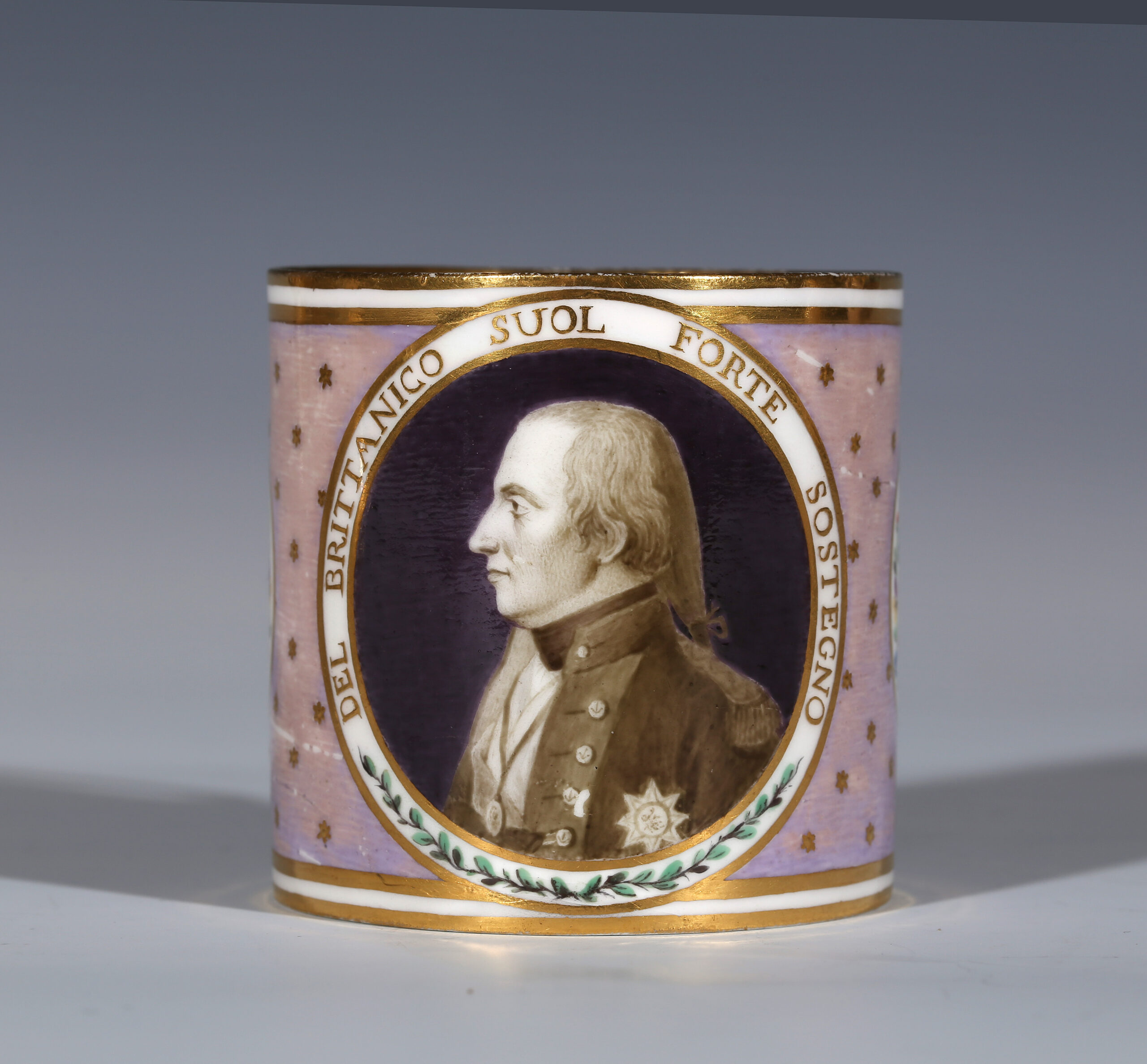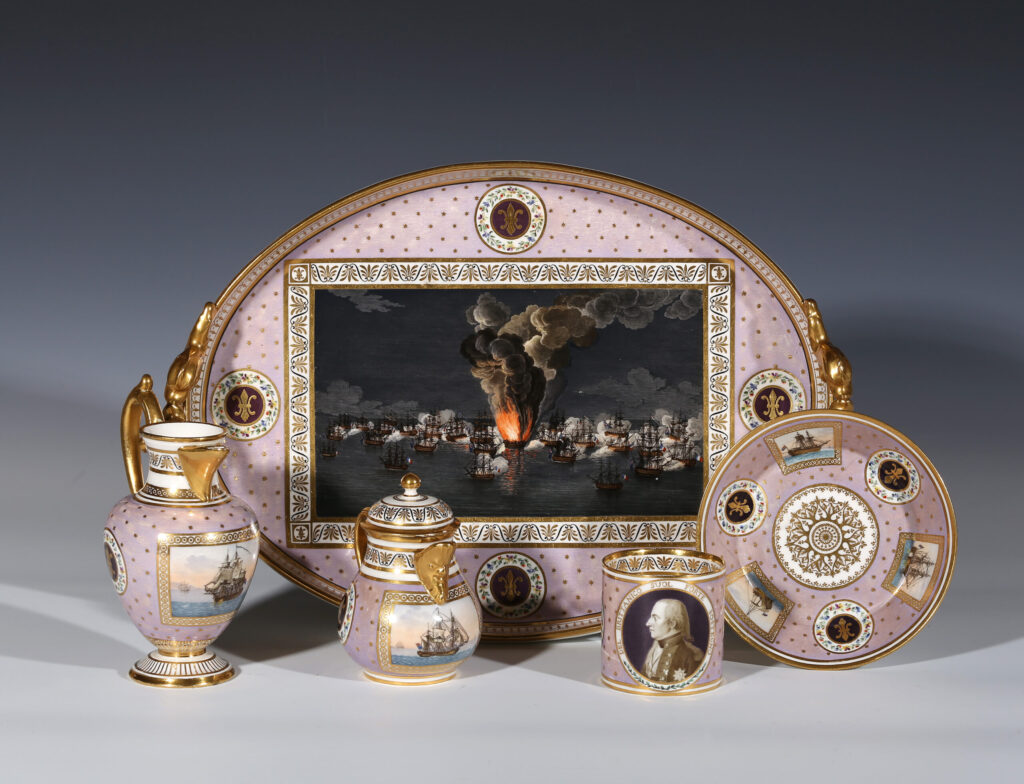
A NAPLES PORCELAIN PART DÉJEUNER
Given by Queen Maria-Carolina of Naples
To Admiral Lord Nelson
Real Fabbrica Ferdinandea, 1798
The tray 35.3 cm. wide
The cup with the crowned ‘N’ mark in blue
The tray inscribed on the reverse:
‘Combattimento tra la Squadra Inglese, e Francese coll’incendio del
Vascello Oriente accaduto nella Rada d’Alessandria
Il pr:mo Agosto 1798’
The portrait of Nelson on the cup is surrounded by the text:
‘DEL BRITTANICO SUOL FORTE SOSTEGNO’[1]
This part service includes a previously undocumented portrait of Lord Nelson drawn in the immediate aftermath of the Battle of the Nile and an unrecorded view the Battle itself[1]. It comprises a gilt-metal mounted tray, a milk jug and cover, a cup and saucer and a hot water jug. The scenes are painted on a lilac ground with roundels of fleur-de-lys, the emblem of the Bourbon Kings of Naples and Sicily.
The tray is painted with a scene from the climax of the Battle of the Nile (also known as the Battle of Aboukir Bay) which occurred on the evening of 1 August 1798 and where Rear-Admiral Sir Horatio Nelson won a decisive victory against the French fleet in which the French flagship, Orient, exploded spectacularly.
News of the victory at the Nile was brought to Naples ahead of Nelson by Lieutenants Bladen Capel and William Hoste, who were swept into Lady Hamilton’s carriage and triumphantly paraded through the streets accompanied by Lady Hamilton wearing a headband inscribed ‘NELSON AND VICTORY’[2].
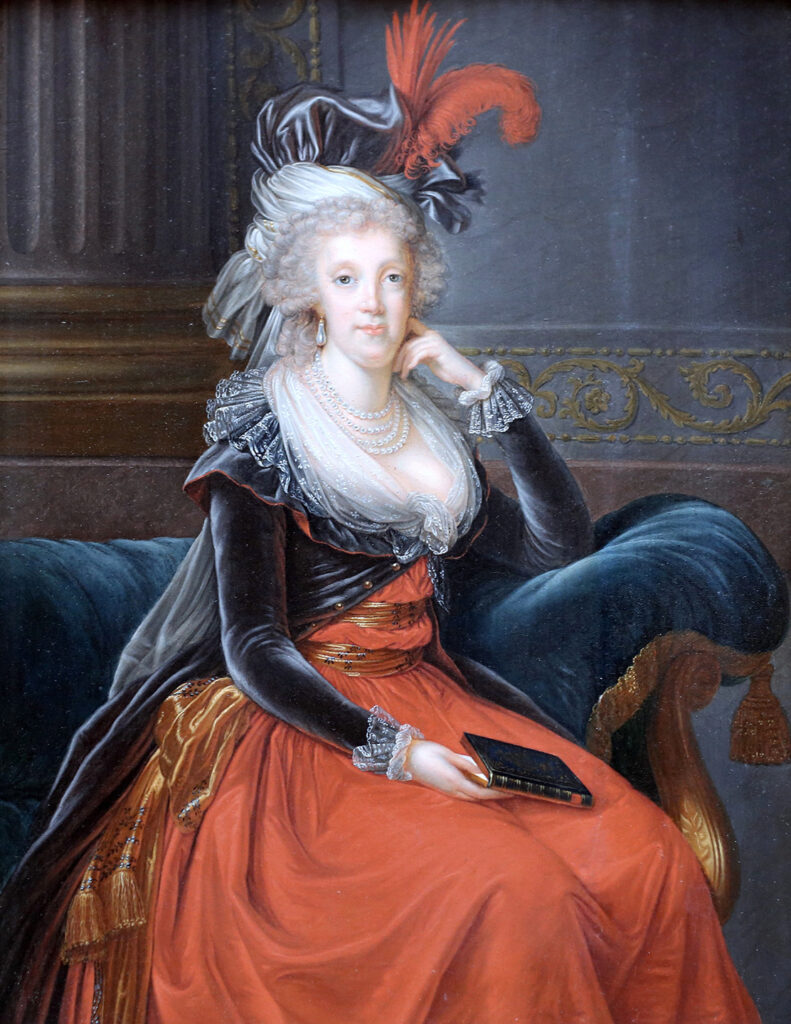
Vigée Lebrun, Queen Maria-Carolina, Condé Museum, Château de Chantilly
Queen Maria-Carolina was in an ecstasy of joy at the news, as Emma Hamilton wrote to Nelson:
She fainted, cried, kissed her husband, her children, walked frantic about the room, cried, kissed and embraced every person near her, exclaiming, “Oh, brave Nelson; Oh God bless and protect our brave deliverer. Oh, Nelson, what do we not owe you! Oh, victor, saviour of Italy. Oh, that my swollen heart could now tell him personally what we owe to him”[3].
On 22 September 1798 a battered and wounded Nelson sailed into the Bay of Naples in the Vanguard, his flagship, and was met with a joyous welcome by the King and the Hamiltons, who came out to greet him in a barge.
This service was commissioned as a personal gift of Queen Maria Carolina shortly after his arrival. Nelson and the Hamiltons visited the Royal Porcelain Factory at Portici in early October where the service, ordered by the Queen to be decorated with his portrait and scenes from the various engagements in which he had taken part, was already in hand[4]. According to Angela Caròla Perrotti this service was one of the many gifts that Queen Maria Carolina and King Ferdinand IV gave to Nelson in gratitude for his help in that year.
Payment for this service is recorded at the end of a letter of 7 April 1800 from Giacomo Sperdutti in the archives of the Real Fabbrica Ferdinandea which states:
Your Excellency
…. After the entry of the victorious army of the King of Naples and the Sicilies. A Royal Dispatch of 3 December of last year 1799, ordered me to pay myself monthly duc. two thousand either in cash or in poliza with the bonifica dell’agio.
Also ordered with another Royal commission on the 3rd of the month, another 1000 ducati for the production of a déjeuner ordered by S.M. The Queen as a personal gift to the English Admiral Nelson[5].

The cup is painted with an otherwise unknown portrait of Nelson in profile wearing the Star of the Order of the Bath, and his captain’s gold medal for the Battle of Cape St Vincent, the only decorations that he held at the time of the Battle of the Nile[6]. Nelson had lost his right arm at Santa Cruz, Tenerife, on 25 July 1797, and his empty right sleeve is just visible across his breast where it is attached by a loop to the fourth button of his coat.
Later portraits from shortly after this moment show Nelson wearing the Nile Medal, which was announced on 7 October 1798 and which he received on 9 January 1799[7], and also the Ottoman Order of the Crescent, created for Nelson by Sultan Selim III, which he received with the diamond-set chelengk, brought to Naples aboard HMS Alcmene on 13 December 1798, as well as the Order of Saint Ferdinand and of Merit of the Kingdom of the two Sicilies and the Sardinian Order of St Joachim[8].
Nelson had first achieved widespread public recognition following his daring conduct at the Battle of Cape St Vincent in 1797, but it was only after the Battle of the Nile that he became the pre-eminent national hero. By 1797 the first (fairly crude) popular engraving of him by Robert Shipster of Woolwich had appeared. It was after the oil portrait of 1781 by J.F. Rigaud[9]. A curious mezzotint by Robert Laurie also appeared in that year[10]. Lemuel Francis Abbott painted the well-known half-length portrait, from which he later produced some 40 versions, while Nelson was staying with Locker at Greenwich in the autumn of 1797. This was used for the mezzotint, extended to a full-length portrait, published by William Barnard in two versions: the first in May 1798, just before the Battle of the Nile, and another in November.
Our portrait bears no relation to these other known depictions. Being in profile to the left it conceals the ugly wound and missing eyebrow over his right eye that he suffered from a flying shot fragment during the Battle of the Nile. This caused a large flap of the skin from his scalp to cover his good eye causing him for a moment to fear blindness. In our image the hair is untypically short at the front, presumably because his forelock would have been shaved to treat the wound. This portrait depicts Nelson as he was in September or October of 1798, and must have been taken from life at the time.

Leonardo Guzzardi v. 1798-99, Government Art Collection Acc. No. 15080
The earliest versions of the portrait by Leonardo Guzzardi, where he is also just wearing the St Vincent medal and the Order of the Bath, clearly show the wound over his right eye and his hairline concealed by the unusual angle of his bicorn hat[11]. In subsequent portraits Nelson generally wore his hair swept forward[12].
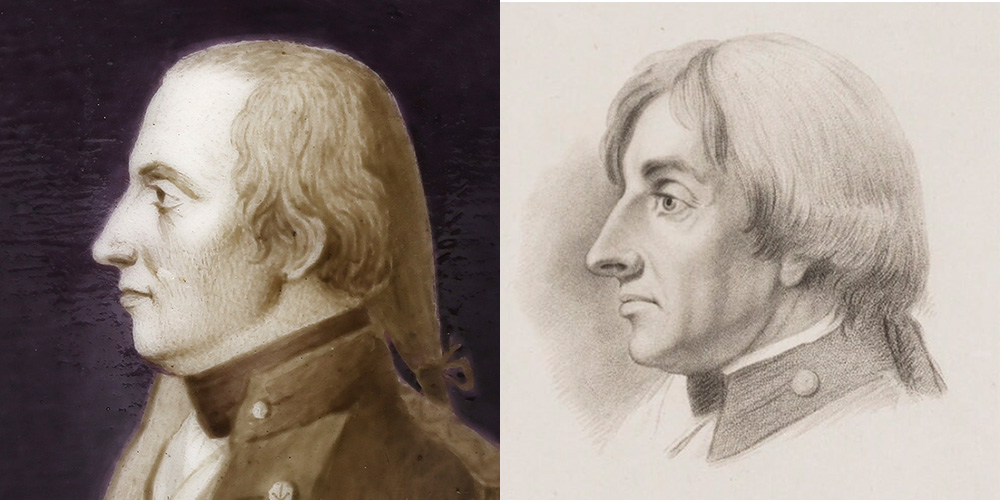
Our portrait with the shaved forelock and an engraving after the sketch by Simon de Koster drawn from life on the 11th December 1800 on Nelson’s return to England

Detail of the tray
Like the portrait of Nelson, the depiction of the Battle of the Nile is not from any known source and must be by a skilled artist and based on first-hand accounts and sketches of naval officers who were themselves often competent draughtsmen. While there were older precedents for aerial battle views of this sort in Dutch late 17th-century marine painting, notably by William van de Velde the elder, they are relatively rarer thereafter in work by their British successors until Nicholas Pocock produced an oil set of Nelson’s victories that were engraved in his first major biography in 1809[13]. The best-known depictions of the battle are generally from eye-level[14].
The British ship in the background immediately right of the exploding Orient on the tray seems to have a plain blue flag at the maintop, indicating the second division, as well as a blue ensign: that identifies it as Leander. The British ships at anchor from right to left are Alexander, Orion, Audacious, Theseus, Zealous and Goliath. The French ships closest to the bottom of the picture are single decker French frigates shown lying inshore of the mainly two-decker line-of-battle ships, Justice, Diane, Artemis, Serieuse. To the left on the horizon is the Aboukir Fort.
All the ships are correctly flying blue ensigns, Nelson’s colour as a rear admiral ‘of the blue’ division at the time. His flagship Vanguard is not depicted on the ‘form’ pieces but may have been on a matching teapot or sugar bowl, assuming one originally formed part of the set. The milk jug shows a two-decker, probably representing one of the 74-gun ships that made up Nelson’s squadron at the battle. The smaller ship on the hot water jug has a single gundeck mounting seven visible guns a side, which suggests an 18- or 20-gun sloop rather than a frigate. The vessels on the saucer include a Royal Navy brig, apparently firing a salute, conceivably the brig Mutine, of which Thomas Masterman Hardy was ‘Master and Commander’ at the Nile. The others are a lateen-rigged Neapolitan boat flying the blue ensign and perhaps a partly dismasted ship.
Nelson encouraged King Ferdinand in his, initially successful, conquest of Rome in November 1798, and then, after he was defeated, facilitated the Bourbon Royal family and the Hamiltons escape to safety in Palermo in January 1799. For six months a new Jacobin administration was established in Naples – the Parthenopean Republic – led by some of the liberal aristocracy and intelligentsia. After its defeat Nelson brought the King back to his capital on 8 August 1799. He was granted the Dukedom of Bronte in Sicily by the King on 10 October 1799. This ‘post-Nile’ period in Naples was the most controversial of his career, during which he was often acting contrary to Admiralty wishes. The result, in 1800, was both his own recall to England and that of Sir William Hamilton as British envoy to the Kingdom of the Two Sicilies on the arrival of his replacement Artur Paget.
The tray is mounted in gilt metal, a very rare feature that Angela Caròla Perrotti says is only found on objects made for the court or important gifts such as the Herculaneum Service sent to Charles III in Spain.
This service descended in the Brymer family, who had a number of tangential connections to Nelson. In 1861 John Brymer, Esq., bought Islington House in Puddletown, Dorset from the Walpole family, relations of Nelson on his mother’s side. He was a pallbearer with Horatio, 3rd Earl Nelson (1823–1913) at the funeral of Walter Kerr Hamilton, Bishop of Salisbury, in Salisbury cathedral in August 1869 (reported in the Western Gazette and Flying Post of Friday, 13 August) and his daughters also married naval officers. John Brymer’s father, Alexander Brymer (1745–1822), made a fortune in Nova Scotia as a naval prize agent and as a large supplier of wine and spirits to the late-18th-century Navy, before returning to England in 1801.
We are very grateful to Angela Caròla Perrotti, Dr Pieter van der Merwe, Greenwich Curator Emeritus, National Maritime Museum, and Louis Hodgkin for help with this entry.
Condition:
Tray with a couple of light glaze lines. The lid of the milk jug with a minute flake to underside of rim. Saucer broken and restuck. Hot water jug lacks its cover and has repaired handle. Large section of spout/rim reattached.
Provenance:
The Property of John Brymer, Esq., Sotheby & Co. London, 16 July 1968, Lot 223
Acquired by Robert W. Hompe, then by descent
Pook and Pook Inc. Auctions, USA
References:
Caròla Perrotti 1978
Angela Caròla Perrotti, La Porcellana Della Real Fabbrica Ferdinandea 1771-1806, (Di Mauro Editore 1978)
Oman 1947
Caroline Oman, Nelson, (Hodder and Stoughton 1947)
Pocock 1994
Tom Pocock, Horatio Nelson, (1987, Pimlico edition 1994)
Romano 1959
Elena Romano, La porcellana di Capodimonte, (1959), p. 133
Walker 1998
Richard Walker, The Nelson Portraits, An iconography of Horatio, Viscount Nelson, K.B. Vice Admiral of the White, (Royal Naval Museum Publications, 1998)
Price: £180,000

[1] ‘The great defender of British Soil’.
[2] The historical sequence of known portraits of Nelson have been meticulously documented by Richard Walker, in The Nelson Portraits, An iconography of Horatio, Viscount Nelson, 1998.
[3] Walker 1998, p.57.
[4] Pocock 1994, p. 171.
[5] Oman 1947, p. 316.
[6] Caròla Perrotti 1978, pp. 46–47 & p. 50, Angela Caròla Perrotti notes that there is little information on the ‘official’ production carried out on the King’s orders in these years. She records that a service for Admiral Nelson was completed, which in fact had been made before 1799, so these were simply completion payments. The difficulties encountered by the administration in meeting the expenses for these gifts suggest that they would not otherwise have been ordered: the current times no longer allowing for such grandiosity. Further gifts of porcelain to Nelson were recorded between 1804 to even after his death in 1806.
[7] Nelson had received his St Vincent gold medal when cruising off Cadiz in May 1797. He had been invested with the Order of the Bath by King George III on 25 September 1797 at St James’s Palace, before setting off for the Mediterranean.
[8] Walker 1998, p. 65.
[9] Nelson was granted permission from George III to wear these foreign orders.
[10] Painted for his old captain, William Locker, who was by then Lieutenant-Governor of Greenwich Hospital. Walker 1998, p.11.
[11] Walker 1998, p. 16. This was adapted from a miniature belonging to Lady Nelson known as the Leghorn miniature. Robert Laurie changed the uniform to that of a rear admiral, adding the Bath insignia and removed his right arm.
[12] The first version of 1789-90 was commissioned by Sir William Hamilton and now hangs in the Admiralty boardroom (Walker 1998, no. 77, p. 82).
[13] The portrait drawn from life on 11th December 1800 of Nelson in profile looking to the left by Simon de Koster (Walker no. 164) shows the forelock grown back.
[14] These included the Nile, Copenhagen and Trafalgar that were engraved for Clarke and McArthur’s ‘The Life and Sources of Horatio, Viscount Nelson, from his Lordship’s manuscripts’ in 1809.
[15] Such as those by Thomas Whitcombe, George Arnald, Mather Brown, Thomas Luny, and others (many in the National Maritime Museum).



